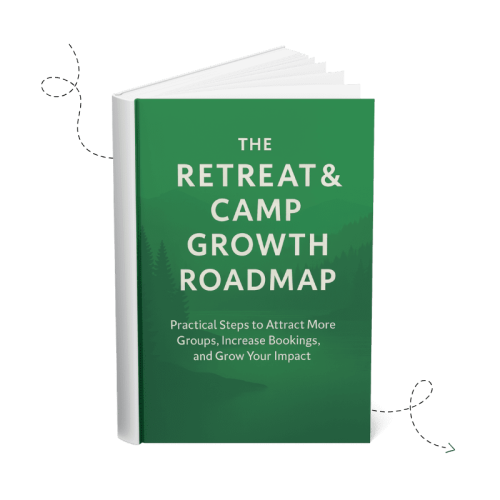Retreat & Camp Growth Roadmap Focus Area: Create Landing Pages
Introduction
Most retreat centers and camps serve a wide variety of guest groups—youth, men, women, families, schools, churches, and more. But when all these audiences land on the same generic web page, it’s easy for your message to miss the mark. That’s where tailored landing pages come in.
Creating a dedicated landing page for each group type or program offering helps your center show up in search results, speak directly to your audience’s needs, and increase the chances they’ll inquire or book. When done well, these pages become one of your most powerful tools for growth.
Why This Focus Area Matters
Group leaders are searching online for retreat options that meet their specific needs, whether it’s a women’s ministry retreat, a team-building day for students, or an outdoor adventure for families.
If your website speaks to everyone at once, it effectively speaks to no one in particular. Tailored landing pages allow you to:
- Increase conversions by aligning content with audience needs
- Improve search engine rankings through targeted keywords
- Support advertising campaigns and on-site navigation with clear next steps
- Serve your mission more effectively by connecting with the right groups
This focus area is about stewardship. It helps you make the most of the opportunities God is already placing in front of you by showing up clearly, helpfully, and with purpose.
Is This an Area You Need to Focus on Right Now?
Ask yourself:
- Does your website have dedicated pages for each of your offerings?
- Do you have dedicated pages for each type of group you target or program you offer?
- Are these pages being used as landing pages for your marketing campaigns?
- Have those pages been intentionally designed to drive conversions?
- Are you getting a 5% or better conversion rate from those pages?
If you answered “no” to any of these, this focus area can help you bring greater clarity, alignment, and impact to your outreach.
What Landing Pages Actually Do (and Why They Matter)
A landing page is a standalone web page created specifically to address the needs of a particular audience or program. Unlike general site pages that serve everyone, landing pages are focused, action-oriented, and designed to move the visitor toward a single goal—like submitting an inquiry or scheduling a call.
Landing pages serve two critical purposes:
- As a destination from outside your website
Whether someone clicks a Google Ad, a Facebook post, or finds you through search, that visitor should land on a page that speaks directly to their interests. If they’re searching for a “women’s ministry retreat near me,” they shouldn’t be dropped on a general “book a retreat” page. They should land on content tailored to women’s ministry leaders. - As a next step within your website
Visitors often start at your homepage or a general retreat overview. Group-specific landing pages serve as the next click that helps them find content most relevant to them. This creates a smoother user experience and increases the chances they’ll inquire.
In both cases, the landing page should:
- Engage the visitor with relevant messaging
- Convince them with targeted information and visuals
- Build trust with testimonials and clarity
- Prompt action with a simple form or scheduling option
These are trust-building tools that guide someone from interest to inquiry. A high-performing landing page is built to drive conversions—meaning it turns website visitors into inquiries. In web marketing, the percentage of visitors who complete an intended action (like filling out an inquiry form) is called a conversion rate.
On average, landing pages convert at 2–3%. But for well-designed, targeted retreat landing pages, we often see conversion rates in the 5–7% range or even higher. That means for every 100 visitors to a page, five to seven will submit an inquiry. That can quickly add up.
When these pages are optimized for search, they also attract organic traffic. If someone searches for “men’s retreat center near me,” and lands on a page designed just for that audience, they’re far more likely to take the next step.
Even small increases in conversion rate can have a big impact. For example, if your youth retreat page currently receives 1,000 visits a year and converts at 2% (20 inquiries), improving that to 6% would result in 60 inquiries—tripling your leads from the same amount of traffic. That’s powerful stewardship of your existing resources.
Putting This Focus Area into Practice
Now that you understand why landing pages matter, it’s time to apply what you’ve learned. This section walks through the practical steps of building, structuring, and optimizing landing pages that align with your mission and speak directly to the groups you serve. Whether you’re just getting started or refining what you already have, this guidance will help you take faithful and focused steps forward.
Map Out Your Landing Pages
Begin by identifying which landing pages you need. Take inventory of what already exists on your website and compare it to the group types and program offerings you currently promote. Where there are gaps, start by addressing the highest-priority ones. Even if you already have a landing page for a particular audience or offering, take a fresh look at it. Many older pages may be too general, lack strong calls to action, or be missing key elements like visuals, testimonials, or SEO optimization. Don’t just assume a page is “done”—use this process to evaluate whether it’s truly effective and aligns with the best practices outlined here.
Focus first on your core offerings—these are the big-picture offerings that form the foundation of your ministry’s outreach. Depending on the scope of your organization these might include:
- Retreats
- Camps
- Outdoor Education
- Team Building
- Outdoor Activities
- RV & Campsite Rentals
Your website should include a clear, dedicated landing page for each of these main offerings, as they represent distinct types of guest experiences and attract different kinds of planners.
From there, create individual pages tailored to specific programs or target audiences within each category:
- For Retreats: men’s retreats, women’s retreats, youth ministry retreats, marriage retreats, singles retreats, family retreats
- For Camps: youth camps, adventure camps, leadership camps, day camps
- For Outdoor Education: middle school programs, high school enrichment, homeschool days
- For Team Building: school groups, corporate retreats, church staff retreats
This structure helps visitors quickly find content that’s most relevant to their interests and creates a user journey that builds clarity and trust from the first click.
Landing Page Best Practices
Before diving into the anatomy of a high-performing landing page, it’s helpful to summarize the best practices that underlie all great landing page design. These principles are drawn from industry-proven strategies tailored to the needs of retreat centers and camps. While there’s room for variation based on your audience and mission, these best practices serve as a foundation for creating pages that connect, convert, and reflect your unique calling.
- Keep the content focused. Each page should feel like it was written for that specific visitor. Stay consistent with your brand voice, but tailor each page to the unique questions, hopes, and challenges of your audience. For example, a youth pastor wants a safe, spiritually impactful, fun environment for students, whereas a women’s ministry leader may want comfort, connection, and rest.
- Use strong headlines and subheadlines. Most users skim first, so your headlines should stand out and deliver clear, impactful messages. A headline should identify who the page is for, and a subheadline should highlight your USP or core benefit. For example, “Plan Your Women’s Ministry Retreat” paired with “Rest, renewal, and reconnection for your group in a Christ-centered setting” instantly signals relevance and value.
- Show real people and authentic experiences. Visuals are a powerful trust signal. Include videos or images of your property that show real guests having authentic experiences. This will help viewers instinctively imagine themselves and their group in that same experience.
- Make the next step obvious. Use clear, well-placed calls to action and make it easy to convert by providing an inquiry form, registration form, or whatever next step is relevant for that page.
- Include trust builders. Add testimonials, reviews, partner logos, and guest stats. Feature these near your calls-to-action. They show others have trusted you—and been glad they did.
- Support SEO and organic discovery. Use keywords, meta tags, and internal links to help people find your page.
These practices all come together in the structure of your page. In the next section, we’ll break down the anatomy of a high-performing landing page to show you how to put each of these principles into action.
The Anatomy of a High-Performing Landing Page
Here’s a general outline of what a high-performing landing page should include. This framework is based on proven best practices from the retreat, service, and broader marketing industries. While you don’t need to follow it rigidly, it provides a reliable structure to help you build trust, improve clarity, and encourage action. Think of it as a helpful starting point you can adapt to fit your unique brand, mission, and audience.
1. Strong Hero Section
The hero section is the first thing your visitor sees—and the first chance to earn their trust and interest. It should be designed to quickly answer the question: “Is this for me?”
- A bold, clear headline that declares what the page is about and who it’s for. For example: “Plan Your Next Women’s Ministry Retreat in the Mountains.”
- A subheadline that addresses the audience’s core need or desire and incorporates your Unique Selling Proposition (USP). For example: “A peaceful, all-inclusive space where your group can grow closer to God and each other.”
- A strong hero image or background video that visually reinforces the experience and matches the audience—such as women in worship, youth playing outdoor games, or families gathered by a campfire.
- The primary call to action (CTA) positioned clearly and invitingly, such as a button labeled “Plan Your Retreat” or “Get More Info.”
Together, these elements should provide a confident first impression that communicates clarity, credibility, and care. Done well, your hero section gives the visitor a reason to keep reading—and a reason to trust you.
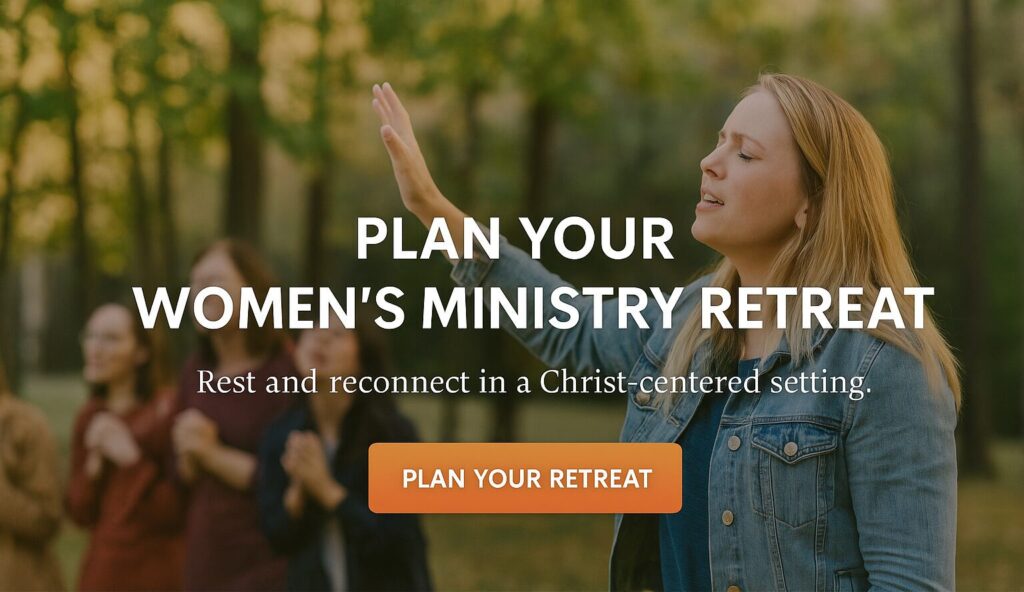
2. Supporting Introduction
Use a short paragraph to clarify the experience and invite them to explore further. This is your chance to speak directly to your visitor in a warm, personal tone that reflects your mission and values. Be specific about what kind of retreat experience you offer and what they can expect if they continue reading.
For example: “Our women’s ministry retreats are designed to be a peaceful space for renewal, connection, and spiritual growth. Whether you’re planning a weekend away or a multi-day gathering, we’ll help you create an experience that refreshes your group’s heart and deepens their faith.”
This brief introduction reinforces your message and prepares the visitor for what’s to come. It should naturally lead them into the next section, where you highlight the key benefits of the retreat and help them imagine what it will feel like to be there.
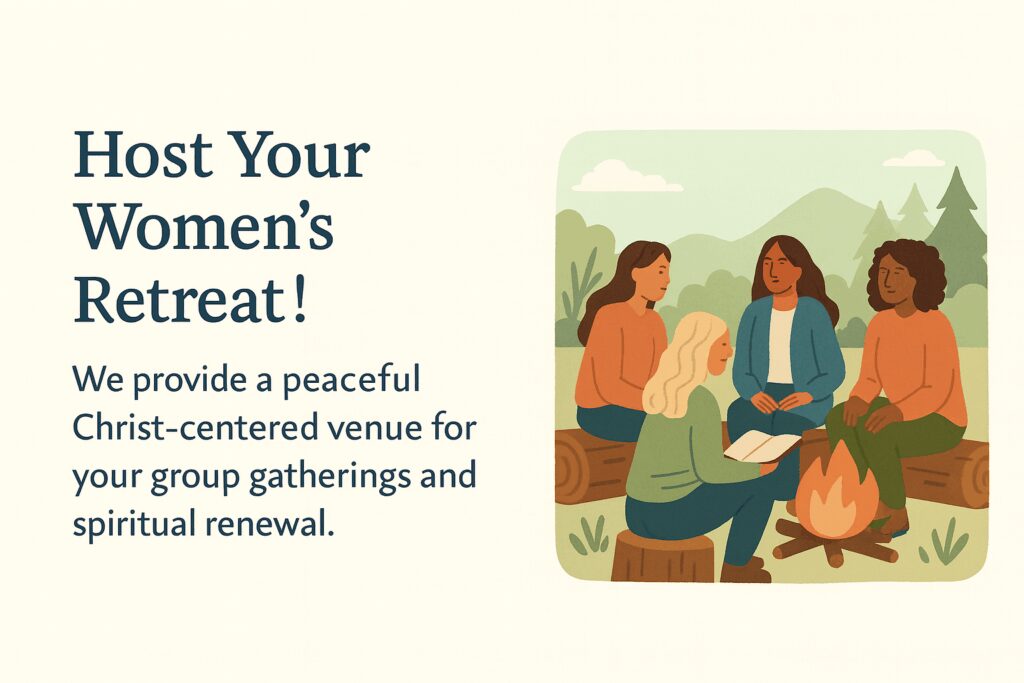
3. Key Benefits or Highlights
This section is where you help your visitor imagine the experience they’ll have at your retreat or camp. Use a concise bullet list of 3–5 value points that highlight the benefits in clear, emotional language. These should speak directly to what your guest will experience, feel, or achieve when they attend.
For example:
- Quiet spaces and beautiful trails for reflection and prayer
- Comfortable lodging and meals included in every stay
- Fun, faith-building activities designed for youth groups
Focus on tangible outcomes and emotional value rather than features. This is your chance to show what makes the experience not just good, but meaningful.
Keep the list visually clean and easy to scan—this is often one of the most-read parts of the page.
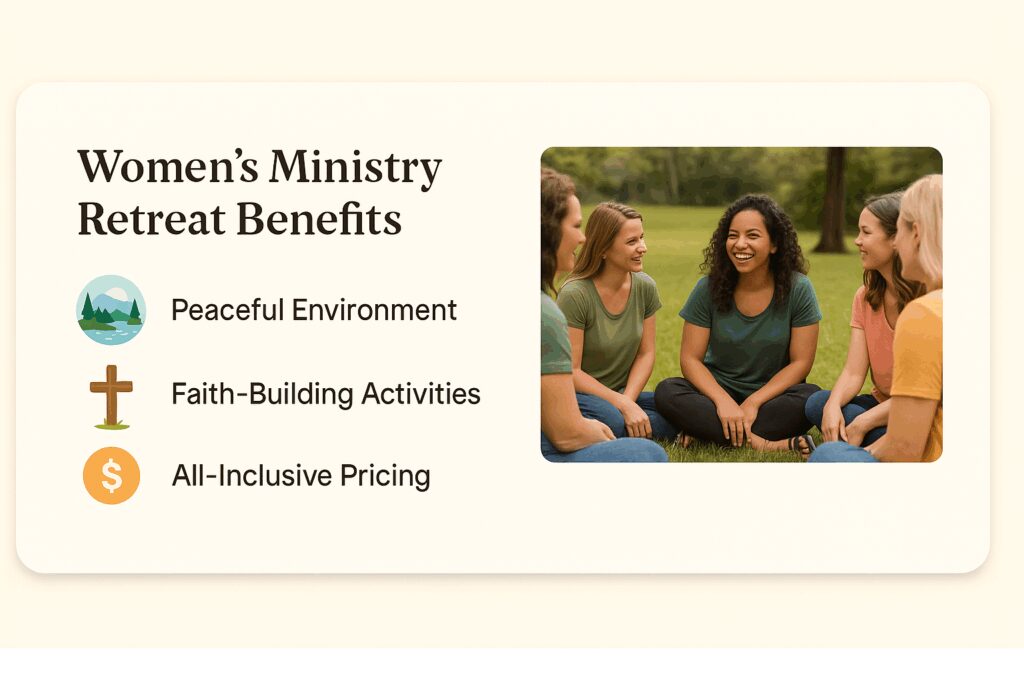
4. Highlight Social Proof Strategically
Social proof is one of the most powerful tools for building trust on a landing page. When a visitor sees that others have had a positive experience, they’re more likely to take the next step themselves. Here are several types of social proof to consider, with examples:
- Testimonials and Reviews: Quotes from past group leaders or attendees add human credibility. Example: “Our youth group had an amazing weekend—everything was so well-organized and meaningful.” Include names, group types, or even a photo when possible.
- Review Ratings: Highlight your star ratings from Google, Facebook, or other platforms. Example: “4.9 stars from 350+ reviews.”
- Guest Stats: Numbers like “Over 10,000 guests served” or “50 years of ministry” communicate experience and reliability.
- Logos: Include visual logos of churches, schools, or organizations that have used your facilities.
- Badges or Seals: Display affiliations, awards, or certifications, such as “Best of [Your Region]” or memberships in relevant associations.
Place these near calls to action or within the flow of the page to reinforce trust at key decision points. Visitors may not read every word on the page, but they will notice these cues—and they matter.
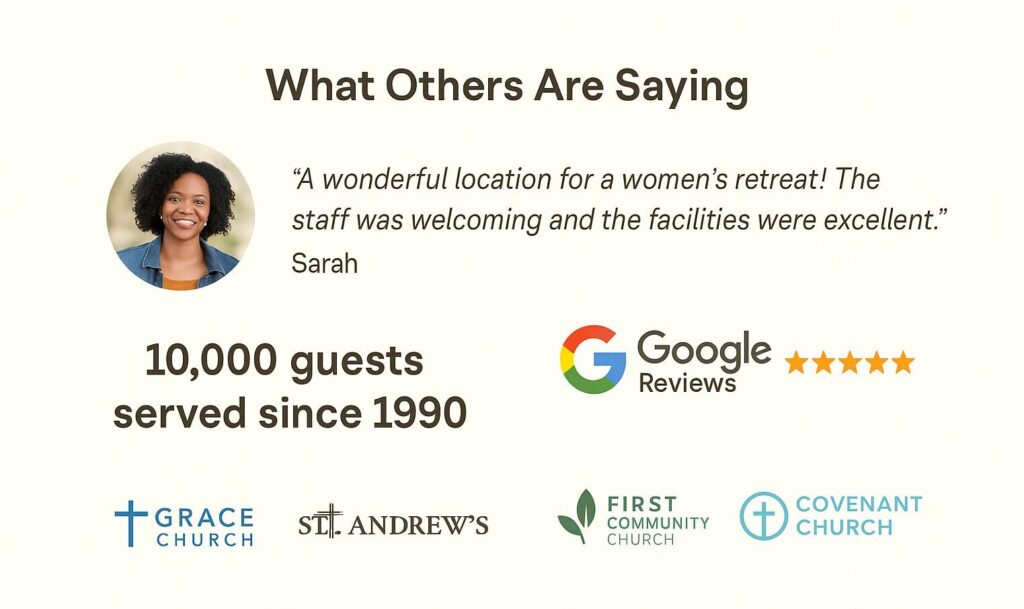
5. Clear Call to Action
Calls to action (CTAs) are the key moments where you invite the visitor to take the next step—whether that’s submitting an inquiry, downloading a guide, or scheduling a call. A strong CTA helps convert passive interest into action.
Use simple, action-oriented language that makes the next step obvious. Phrases like “Plan Your Retreat,” “Get More Info,” or “Check Availability” clearly communicate what the user can expect. Avoid vague phrases like “Click Here.”
Strategic placement is essential. Your primary CTA should appear early (in the hero section), again in the middle of the page, and once more at the end. Repeating it ensures it’s always within reach as your visitor scrolls. Use a visually distinct button color and keep the wording consistent.
The goal is to make it as easy as possible for someone to say “yes”—no confusion, no clutter, just one simple next step.
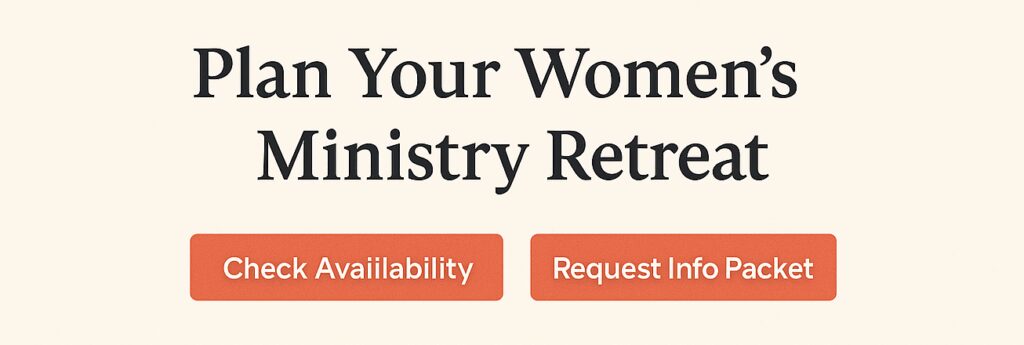
6. Make It Easy to Convert
Once your page has captured attention and built trust, you need to make it easy for the visitor to take action. That’s the purpose of your conversion elements—forms, contact options, and tools that turn interest into inquiry.
For most retreat centers, the main conversion tool is an inquiry form. This should be embedded directly on the page and ask only for essential information: name, contact details, preferred dates, group size, and type of retreat. Keep it short and easy to complete—fewer fields mean more submissions.
For camps or more structured programs, a registration form may be appropriate. If it’s more complex, link to it from a clearly labeled button (e.g., “Start Registration”) and make sure it opens in a smooth, mobile-friendly interface.
In addition to forms, always include a visible phone number and consider adding a chat widget. Some guests prefer to call or text with questions, while others may use chat—especially if it allows them to leave a message when no one is available live.
You want to meet people where they are, and that means offering multiple clear, relevant ways to respond.
A well-placed form or contact option can be the difference between a lead and a lost opportunity. Recap your call to action here and reinforce the next step with confidence and care.
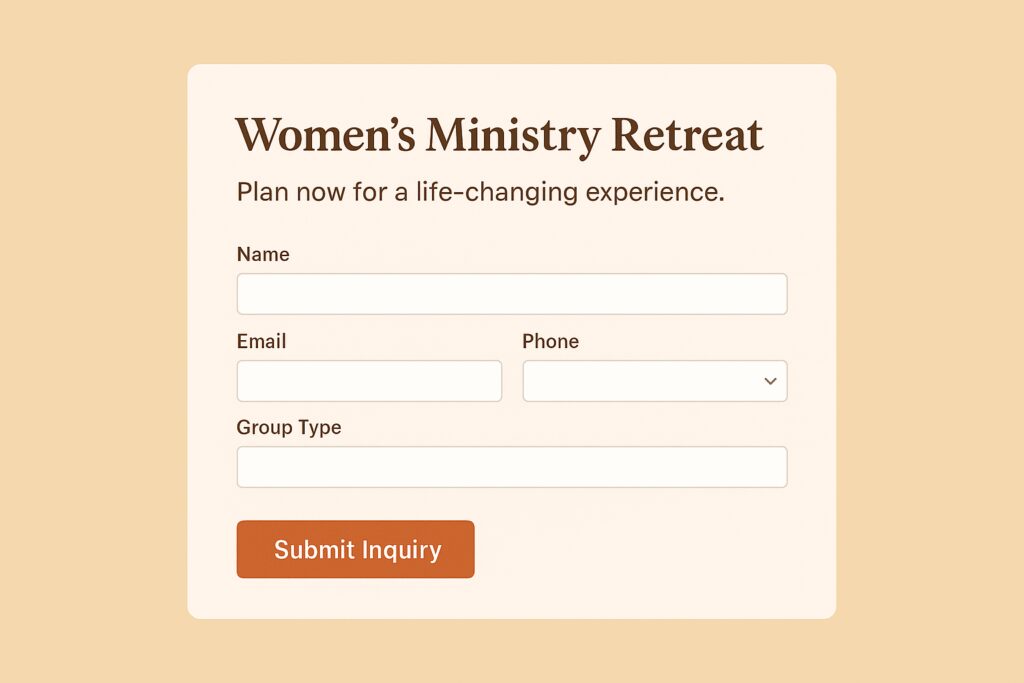
7. Add a Helpful FAQ Section
Including a short FAQ section at the bottom of your landing page helps address lingering doubts and reduces the need for extra back-and-forth emails. Answer 5 to 7 of the most common questions group leaders might have about the experience, booking process, or accommodations. This can reduce barriers to inquiry and improve your page’s search relevance by incorporating natural language and relevant keywords.
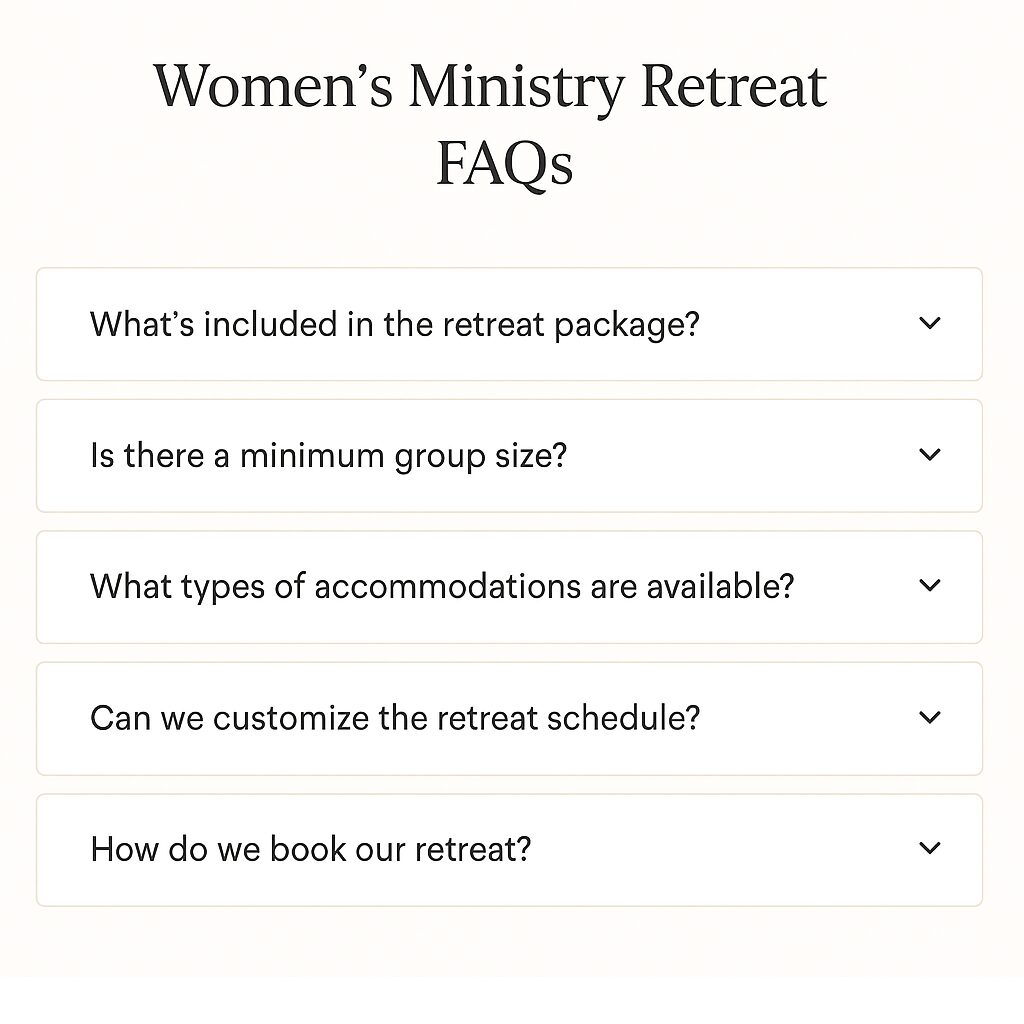
8. Search Optimization
Behind the scenes, your page should have a strong title tag, meta description, and on-page keyword alignment to show up in search. When optimized properly, landing pages can attract highly qualified organic traffic—people who are actively looking for what you offer.
For example, if someone searches for “Men’s Retreat Venue Near Me,” and you have a landing page tailored to men’s retreats with that phrase naturally used in the copy, you’re much more likely to appear in search results. To optimize effectively:
- Use a clear, descriptive title tag, such as “Men’s Retreat Venue | [Your Camp Name] in Ohio.”
- Write a compelling meta description that previews the page, like “Host your next men’s ministry retreat at our peaceful, all-inclusive venue in the heart of Ohio.”
- Integrate target keywords naturally into your headers, body content, and image alt text.
This approach not only brings more of the right people to your site—it brings them to the right page, increasing both traffic and conversions.
Example Landing Page Review
Here’s a link to a real-world example of a group landing page from Refreshing Mountain Retreat Center: Youth Retreat Landing Page
What’s Done Well:
- Headline & USP: “Youth Retreats in Pennsylvania” is clear and geo-specific. Subheading reinforces USP by emphasizing safety, excitement, and ease.
- Hero Visual: A large photo of teens participating in outdoor activities is both engaging and relevant.
- Key Benefits: The bullet points (“Safe. Exciting. Easy.”) are simple, bold, and repeated in visual icons further down.
- Social Proof: Includes testimonials from youth pastors and a large Google review badge.
- CTA & Form: “Plan Your Retreat” is clearly visible and repeated. Inquiry form is clean and mobile-friendly.
This is a strong example of a practical, effective landing page. It doesn’t do everything perfectly, but it gets the essentials right—and that’s what matters most.
📥 Download the Landing Page Planning Worksheet
Use this worksheet to plan a high-performing landing page tailored to a specific group type or program offering. It walks you step by step through each major section of a successful landing page, helping you focus your messaging, plan your visuals, and drive action.
This outline is based on proven best practices in digital marketing and retreat outreach. Treat it as a flexible guide—some sections may need to be adapted depending on your audience, offering, or goals.
📥 Download the Landing Page Planning Worksheet
When completed thoughtfully, this worksheet becomes a foundational tool for building pages that attract qualified traffic and turn interest into action.
Mini Case Study
Refreshing Mountain Retreat Center is a great example of landing page strategy in action. They originally had a general retreat page that mentioned the various types of groups they served and highlighted some amenities. But over time, they realized the value of tailoring content more specifically.
They developed dedicated landing pages for each of their primary group types—such as Youth Group Retreats, Men’s Retreats, Women’s Retreats, and Family Retreats—as well as individual pages for core amenities like lodging, meeting rooms, meals, recreation, and outdoor activities. Each page was customized to its audience and incorporated into the site’s main navigation. These landing pages were optimized for conversion and SEO, and they became key destinations for digital advertising campaigns as well.
The result was a massive increase in qualified traffic and retreat inquiries. To read their full case study, visit: Refreshing Mountain Case Study
Monitor and Adjust for Real-World Results
Even the most well-designed landing page may not perform as expected when it meets real users. That’s why it’s important to monitor how your pages are doing and make informed adjustments. Think of the first 30 to 90 days after launching or updating a page as a learning period.
Start by tracking traffic and conversions using tools like Google Analytics. Pay attention to metrics like:
- How many people are visiting the page
- How long they’re staying
- What percentage are filling out your inquiry or registration form
- Where that traffic is coming from (search, ads, social media)
For a deeper view into how people interact with your page, use heatmapping tools like Microsoft Clarity (a free option). These tools show you where people click, scroll, and hesitate—helping you spot confusing sections or missed opportunities.
Use this insight to test and improve. Try different headlines, rearrange sections, update photos, or simplify forms. Minor changes can make a big difference.
Tracking and testing isn’t about chasing perfection—it’s about listening, learning, and faithfully improving what you’ve already built to serve others better.
Putting It All Together
Landing pages help your retreat or camp speak clearly to the right audience. They guide someone from interest to action, helping you serve with greater clarity and increase bookings without overwhelming your team.
Here are 6 practical takeaways:
- Start with 3 to 5 of your top retreat audiences or programs.
- Tailor content and images for each group type.
- Use strong, simple calls to action.
- Show real people and authentic experiences.
- Optimize for search and mobile experience.
- Track and test your pages to improve results over time.
Ready to Take the Next Step?
Landing pages are more than a marketing tactic. They help you invite the right groups, in the right way, to the experience your center offers.
If you found this helpful, here are four great next steps to continue your journey:
🧭 Move to the Next Focus Area: Activate Search Campaigns
Learn how to reach the right audiences on Google and drive them to your landing pages.
[Read Activate Search Campaigns Blog Article]
📘 Download the Retreat & Camp Growth Roadmap eBook
Get the full 3-stage system we use to help retreat centers and camps grow with clarity and purpose.
[Download the eBook]
🌱 Learn More About How We Help Retreat Centers & Camps
We’re a Christian-owned digital marketing agency that helps retreat centers and camps grow attendance, bookings, and impact through practical strategies rooted in clarity and stewardship.
[See How We Can Help]
🤝 Schedule a Free Discovery Call
Want help applying this to your unique situation? Let’s talk. We’ll explore where you are now, where you want to go, and how to take the next faithful step.
[Book a Discovery Call]
Frequently Asked Questions
- How many landing pages should we create to start?
Start with your top 3 to 5 audiences or programs. These are the groups most central to your ministry and likely to bring the highest return. As you gain insight into which pages perform well, you can expand into additional audience segments or offerings. - What if we don’t have professional photos yet?
Use the best real photos you currently have, even if they’re not perfect. Authentic, relevant images are better than polished stock photography. At the same time, plan ahead to capture more high-quality visuals during upcoming retreats, events, or seasons. - Can one page serve multiple audiences?
Only if those audiences have nearly identical needs, goals, and pain points. In most cases, it’s more effective to create separate landing pages so each one can speak directly and specifically to its target group. This results in higher engagement and better conversion. - How should we promote these pages?
Share them through Google Ads, email newsletters, and social media posts targeted to relevant groups. Also ensure each landing page is linked internally from appropriate spots on your website, such as your homepage or main retreats page, to drive traffic organically. - What makes a good CTA?
A good CTA uses clear, inviting language and makes it obvious what the user should do next. Phrases like “Plan Your Retreat,” “Get More Info,” or “Check Availability” work well. CTAs should be placed in several locations across the page, including the top, middle, and bottom. - Do we need unique designs for each landing page?
No, you can use a consistent design template to save time and maintain brand consistency. However, you should customize the photos, copy, and calls to action so that each page feels personal and relevant to its audience. - How long should each page be?
Long enough to inform, reassure, and prompt action—typically 400 to 800 words. Focus on clarity and value rather than length. Include strong visuals, concise benefit statements, and clear next steps to keep readers engaged. - How do we know if it’s working?
Use tools like Google Analytics to monitor page visits, bounce rate, average time on page, and form submissions. Comparing performance before and after launching or updating pages can show what’s working. You can also use tools like Microsoft Clarity to understand user behavior in more detail.





